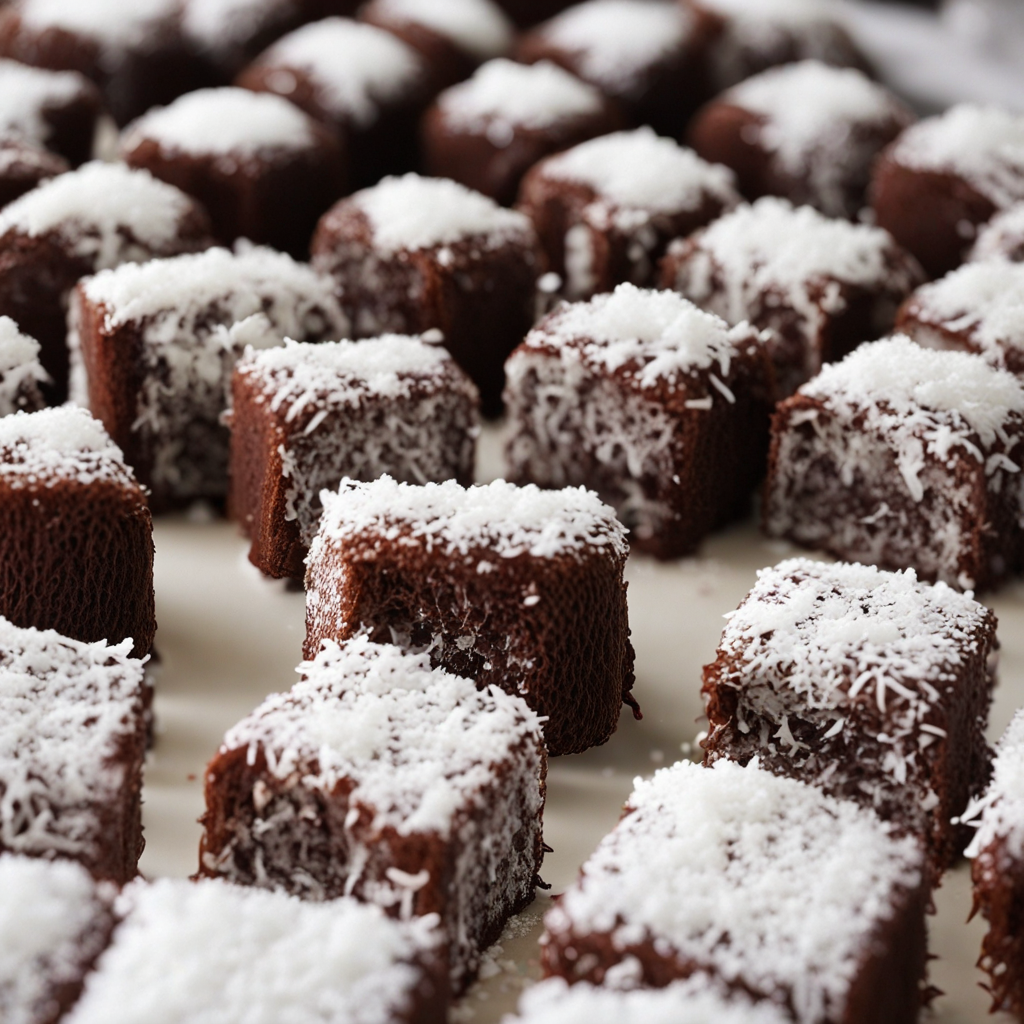Lamington
Lamingtons are a delightful Australian treat that encapsulate the essence of comfort food in a sweet, satisfying package. These square-shaped sponge cakes are first baked to a light, airy perfection. Once cooled, each piece is dipped in a rich chocolate icing that clings to the surface, creating a glossy finish that hints at the indulgence within. The chocolate coating is not overly sweet, allowing the subtle flavors of the sponge cake to shine through, making each bite a balanced experience of sweetness and texture. What truly sets Lamingtons apart is the generous dusting of desiccated coconut that follows the chocolate dip. This adds a delightful crunch and a tropical flair, balancing the soft sponge with a contrasting texture. The coconut also introduces a hint of nuttiness that complements the chocolate, elevating the overall flavor profile. Traditionally, Lamingtons can also be filled with jam or cream, adding an extra layer of richness and a burst of fruity flavor that enhances the cake's moistness. Often enjoyed with a cup of tea or coffee, Lamingtons evoke a sense of nostalgia and warmth, making them a popular choice for afternoon tea or special occasions. Their delightful combination of textures and flavors makes them not only a treat for the palate but also a feast for the eyes, with their charming appearance and inviting aroma. Whether you are enjoying them at a café or baking them at home, Lamingtons offer a unique glimpse into Australian culinary culture that is sure to leave a lasting impression.
How It Became This Dish
The Delicious History of Lamington: Australia’s Iconic Dessert #### Origins of Lamington The Lamington, a delightful sponge cake coated in chocolate and rolled in desiccated coconut, is a beloved treat in Australia, often enjoyed with a cup of tea or coffee. Its origins are somewhat murky, with several anecdotes and theories competing for the title of the “true” story behind this iconic dessert. Most accounts trace the Lamington back to the late 19th century, specifically to the year 1896, in Queensland. One popular story attributes the creation of the Lamington to Lord Lamington, the Governor of Queensland from 1896 to 1901. According to this tale, the cake was invented when a servant accidentally spilled chocolate over a sponge cake while preparing a dessert for Lord Lamington and his guests. The cake was then rolled in coconut to mask the mess, and the guests were charmed by the unexpected treat. This whimsical story, while tantalizing, lacks concrete evidence, and many food historians consider it more folklore than fact. Another theory suggests that the Lamington was inspired by the French dessert known as “gâteau de pâte” or “cake of paste,” which is a sponge cake dipped in chocolate and rolled in various coatings. Given Australia’s history of British colonization and the influence of European cuisine, it is plausible that such a dessert could have been adapted by Australian cooks, leading to the creation of the Lamington. Regardless of its true origins, the Lamington quickly gained popularity in the late 19th and early 20th centuries, becoming a staple in Australian kitchens and tea rooms. It was not long before this delectable dessert became a symbol of Australian hospitality, often served at gatherings, celebrations, and fundraisers. #### Cultural Significance The Lamington has transcended its humble beginnings to become an integral part of Australian cuisine and culture. It embodies the spirit of Australian ingenuity and resourcefulness, turning simple ingredients into a beloved dessert. Its popularity has spread beyond Australian borders, with variations appearing in New Zealand and other parts of the world, yet it retains its distinct Australian identity. One of the most notable cultural events associated with the Lamington is the annual “Lamington Day,” celebrated on July 21st. This day honors the dessert's place in Australian culture and encourages people to indulge in Lamingtons or bake their own. Schools, community groups, and charities often host Lamington drives, selling the treats to raise funds for various causes. The Lamington has thus become a symbol of community spirit and cooperation, connecting people through a shared love of food. Moreover, the Lamington carries nostalgia for many Australians, evoking memories of childhood and family gatherings. It is often featured in lunchboxes and is a popular choice for birthday parties, reflecting the dessert's status as a comfort food. In this way, the Lamington not only serves as a delicious treat but also as a vessel for memory and connection. #### Development Over Time As the Lamington continued to evolve, so did the ways in which it was prepared and enjoyed. Traditional recipes call for a light sponge cake, often made with simple ingredients like flour, sugar, eggs, and butter. The cake is typically cut into squares, dipped in a chocolate icing made from cocoa powder and water, and then rolled in desiccated coconut. However, variations began to emerge over the years. In the early 20th century, bakers started experimenting with fillings, transforming the Lamington into a more indulgent dessert. The addition of jam or cream between layers of sponge cake became popular, giving rise to what is now known as the “lamington sandwich.” This variation adds a delightful burst of flavor and richness, making it a favorite among those with a sweet tooth. The Lamington's versatility has also led to innovative adaptations. Modern bakers have reimagined the classic dessert using alternative ingredients, catering to dietary restrictions and preferences. Gluten-free Lamingtons, vegan versions, and even Lamington-inspired desserts—like Lamington-flavored ice cream or cheesecakes—have emerged in response to changing culinary trends. These adaptations reflect the Lamington's enduring appeal and its ability to resonate with contemporary tastes. In addition to its culinary evolution, the Lamington has made its mark on popular culture. It has been featured in literature, television shows, and even social media, where food bloggers and influencers showcase their creative takes on the dessert. This visibility has helped maintain its relevance in Australian society, especially among younger generations who may be less familiar with traditional recipes. #### The Lamington Today Today, the Lamington remains a quintessential Australian dessert, celebrated for its flavor and simplicity. It is often found in bakeries across the country, from small, family-run establishments to large commercial chains. The dessert has also gained international recognition, with Australian expatriates and enthusiasts promoting the Lamington abroad. In recent years, the Lamington has become a symbol of national pride, particularly during Australia Day celebrations. It is often served at community events, barbecues, and picnics, reinforcing its status as a beloved treat that brings people together. The Lamington is also a popular choice for Australians living overseas, serving as a comforting reminder of home and heritage. As food culture continues to evolve, the Lamington is likely to adapt and change, while still holding onto its rich history and cultural significance. Whether enjoyed in its classic form or reimagined in new and exciting ways, the Lamington will undoubtedly remain a cherished part of Australia’s culinary landscape for generations to come. Conclusion The Lamington’s journey from a serendipitous kitchen mishap to a national icon is a testament to the power of food to create connections, evoke memories, and foster community. As a symbol of Australian culture, the Lamington embodies the spirit of innovation, adaptability, and shared experiences. Its delightful combination of textures and flavors continues to captivate hearts and palates, ensuring that this delectable dessert will endure as a cherished part of Australia’s food heritage.
You may like
Discover local flavors from Australia







